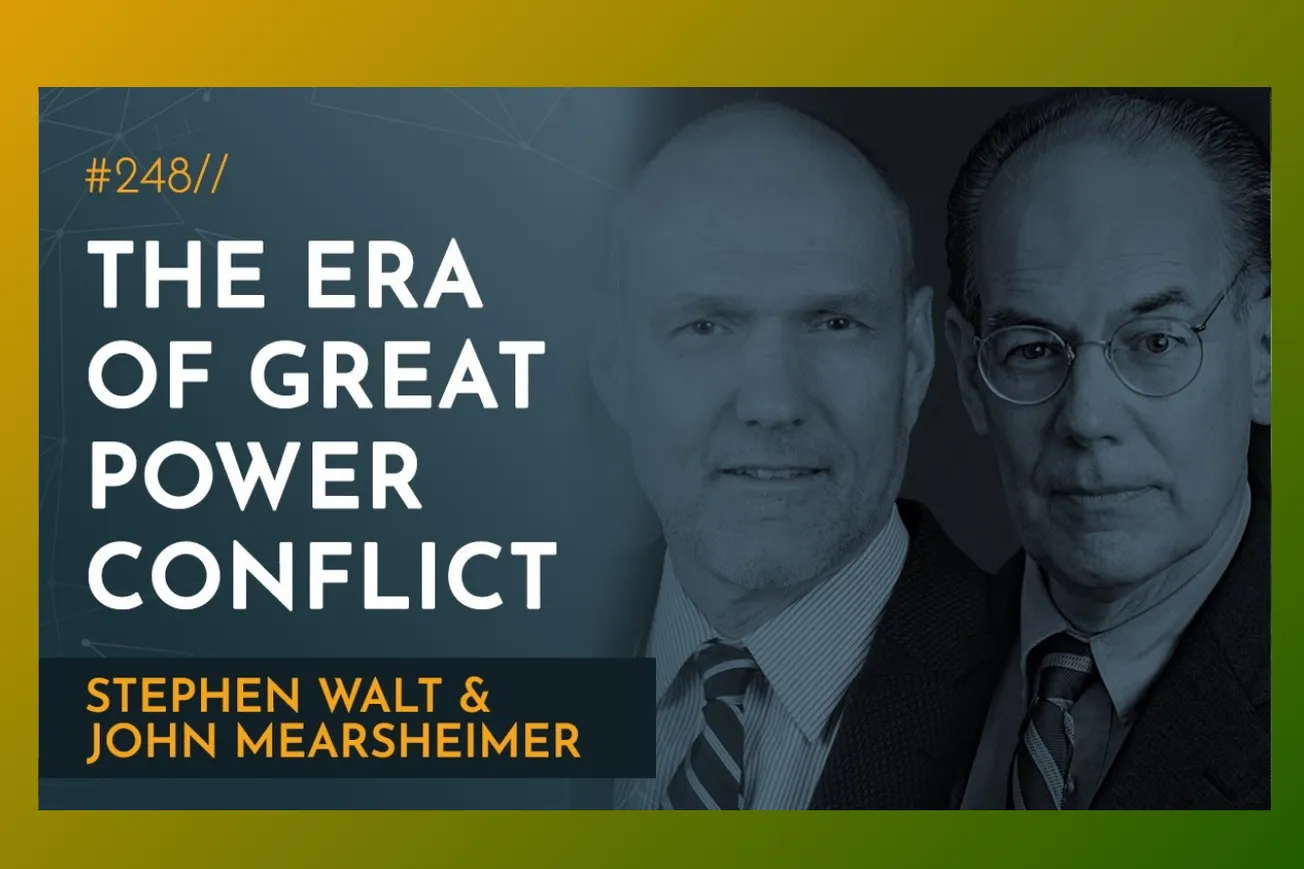Table of Contents
Two giants of international relations theory explain why NATO expansion caused the Ukraine crisis and how nuclear escalation risks threaten global stability.
Key Takeaways
- The Ukraine crisis stems from NATO expansion, not Putin's imperial ambitions, according to realist analysis
- Nuclear escalation risks are significantly higher than policymakers acknowledge, especially if Russia faces existential defeat
- American foreign policy since 1990 pursued liberal hegemony that inevitably generated great power competition
- The current generation of foreign policy leaders lacks Cold War experience with nuclear risks and great power constraints
- Engagement worked with China but failed with Russia due to different institutional imperatives and domestic politics
- Current Ukraine policy undermines the Asia pivot by driving Russia into China's arms and consuming strategic bandwidth
- Public opinion increasingly questions foreign policy establishment narratives, but elite preferences still dominate policy
- The foreign policy "blob" successfully resisted course corrections under both Obama and Trump administrations
- Nuclear weapons create defensive advantages that should enable less threatening military postures between great powers
Timeline Overview
- 00:00–08:15 — Introduction and Realist Theory Foundations: Distinguishing between offensive and defensive realism, the role of anarchy in international systems, and why global hegemony remains impossible
- 08:15–16:30 — Liberal Hegemony and Its Contradictions: How American post-Cold War strategy sought to create a world in its own image while maintaining dominance, and why this approach generated inevitable resistance
- 16:30–24:45 — The China-Russia Divergence: Why the US pursued engagement with China while moving toward confrontation with Russia, including institutional imperatives and domestic political factors
- 24:45–32:20 — Deep Causes of the Ukraine Crisis: Mearsheimer's argument that NATO expansion, not Putin's imperialism, drove the conflict, and the three-pronged Western strategy to make Ukraine a bulwark against Russia
- 32:20–40:15 — The Path to War in 2022: How Biden's support for Ukrainian NATO membership and Russian security demands created an irreconcilable conflict leading to invasion
- 40:15–48:30 — Nuclear Escalation Scenarios: The distinction between nuclear use and nuclear war, and why current US policy creates existential threats that could trigger Russian nuclear escalation
- 48:30–56:45 — Policy Disconnects and Generational Blindness: How current leaders lack Cold War experience with nuclear risks and great power constraints, leading to cavalier attitudes toward escalation
- 56:45–01:04:20 — Strategic Imperatives vs. Current Trajectory: Where American foreign policy should go versus where it's actually heading, and the centrality of the Ukraine crisis to future strategic options
- 01:04:20–01:12:35 — Public Opinion and Elite Resistance: Why Mearsheimer's viral videos resonate with audiences and how the foreign policy establishment maintains control despite public skepticism
- 01:12:35–end — The Asia Pivot Dilemma: Whether the Ukraine conflict helps or hinders the necessary strategic focus on containing China in East Asia
The Realist Framework: Structure vs. Intentions in International Politics
John Mearsheimer and Stephen Walt represent the two main branches of realist international relations theory, offering different perspectives on how states should navigate the anarchic international system. Their debate illuminates fundamental questions about the nature of international competition and the possibilities for peaceful coexistence between great powers.
Mearsheimer's "offensive realism" emphasizes the structural imperatives created by international anarchy. "Because intentions cannot be known with certainty, you can never be sure what another country might do, especially another powerful country might do. There's a strong incentive for states to compete for power, to try and be number one." This uncertainty creates powerful pressures for states to maximize their relative power position, even when no immediate threats exist.
Walt's "defensive realism" acknowledges these competitive pressures but argues for more nuanced analysis. "Although we recognize that states cannot know intentions with a hundred percent certainty, we believe that states can still make intelligent judgements about intentions." This allows for distinguishing between threatening and non-threatening powers based on observed behavior and stated policies, rather than treating all powerful states as equally dangerous.
The practical implications of this distinction become clear in their discussion of nuclear weapons. Walt notes that "nuclear weapons by the way are perfect illustration of this. You can defend yourself by deterring attacks with nuclear weapons, but they're not very useful for conquering other countries." This suggests possibilities for constructing less threatening military postures that provide security without appearing aggressive to neighbors.
Both theorists agree on the central importance of anarchy in creating these dynamics. As Mearsheimer explains, "The fact that the system is anarchic matters enormously. When you say the system is anarchic, that means there's no higher authority that sits above states that states can turn to if they get into trouble." This creates what realists call a "self-help world" where states must ultimately rely on their own capabilities for survival.
Liberal Hegemony: The Post-Cold War American Project
The end of the Cold War created what both scholars describe as a "unipolar moment" that lasted roughly from 1990 to 2017, during which American foreign policy pursued what they term "liberal hegemony." This strategy aimed to "create a world in our own image and we would be the dominant power in that world," as Mearsheimer explains.
The liberal hegemony project had three main components: promoting democracy globally, integrating all states into liberal economic institutions, and embedding countries in international organizations that would make them "rule abiding citizens" and "responsible stakeholders." The underlying assumption was that this transformation would be relatively easy because "the rest of the world kind of wanted to move in that direction."
Walt emphasizes the benevolent nature of this hegemonic vision: "The image of hegemony here was not a coercive one, if it all worked out. We weren't going to be the Roman Empire. We were going to be a very benevolent hegemon with a very light touch." This reflects the influence of Francis Fukuyama's "End of History" thesis, which suggested that liberal democracy represented the final form of human government.
The strategy also included maintaining such overwhelming military superiority that potential competitors would abandon any thoughts of challenge. The 1992 Defense Planning Guidance explicitly stated that America "should be maintain a position of power so great that potential competitors think it's just going to be too hard to catch up to the United States."
However, this approach contained inherent contradictions that both scholars argue made great power competition inevitable. By definition, hegemony requires other states to accept subordinate status, which powerful countries with their own interests and values will eventually resist. The very success of American efforts to integrate competitors into the global economy provided them with the resources to challenge American dominance.
The Engagement Paradox: China vs. Russia
One of the most striking aspects of post-Cold War American strategy was the decision to pursue engagement with China while gradually moving toward confrontation with Russia. This divergence reveals important insights about how institutional imperatives and domestic politics shape foreign policy choices.
With China, American policymakers believed that "by making China rich and incorporating it into international institutions, that would eventually lead to China becoming a liberal democracy looking like the United States." The assumption was that economic development would create middle-class constituencies demanding political liberalization, eventually displacing the Communist Party through peaceful evolution.
This strategy had bipartisan support across multiple administrations. "Republicans as well as Democrats" participated in what Mearsheimer calls turning "China into a peer competitor." The policy enjoyed support from business constituencies benefiting from trade and investment opportunities, creating powerful domestic coalitions supporting continued engagement even as strategic competition emerged.
Russia presented different challenges and opportunities. In the 1990s, Russia was "really in free fall" economically and politically, creating what appeared to be a window for integrating it into Western institutions. However, NATO expansion proceeded despite Russian objections, driven by several factors Walt identifies: Eastern European countries "pushing for this rather quickly," NATO's need for "a new mission" after the Cold War, and domestic political calculations by Bill Clinton to "win some votes in the '96 election by appealing to various ethnic groups."
Crucially, American policymakers "did not view Russia as a threat until 2014" despite expanding NATO eastward. This suggests that NATO expansion was not originally designed as containment but rather as institution-building that ignored Russian security concerns. As Walt notes, "We were contemptuous of Russia's security concerns" rather than actively hostile.
The turning point came with the 2014 Ukraine crisis, when America adopted what Mearsheimer describes as a "confrontational policy toward Russia" for the first time since the Cold War ended. This shift was compounded by the 2016 election aftermath, when "Democrats decided by and large to blame Russian interference for [Hillary Clinton's] loss," creating domestic political incentives for anti-Russian policies.
Ukraine: NATO Expansion vs. Imperial Ambition
The two scholars present a fundamentally different interpretation of the Ukraine crisis from the mainstream narrative that emphasizes Putin's imperial ambitions. Their analysis focuses on what they see as the structural causes rooted in NATO expansion and Russian security concerns.
Mearsheimer explicitly rejects the conventional wisdom: "The conventional wisdom in the United States, which is widely accepted is that Putin is imperialist. And what he is trying to do is either create a greater Russia or recreate something akin to the former Soviet Union. That's the conventional wisdom. That's wrong. There is, in my opinion, no evidence to support that."
Instead, he argues that "the deep cause of this crisis was the West effort. And here we're talking mainly about Washington's effort to make Ukraine a Western bulwark on Russia's border." This strategy had three components: bringing Ukraine into NATO, integrating it into the EU, and promoting the "Orange Revolution" to create a pro-American liberal democracy.
The Russian response was consistently negative. "Putin made it unequivocally clear, and his lieutenants made it unequivocally clear that this was an existential threat to Russia and that Russia was not going to tolerate it." This wasn't a new development in 2021-2022 but a longstanding position that American policymakers chose to ignore.
Walt provides crucial context for understanding Russian motivations by examining the broader pattern of US-Russian relations: "If you take the last 20 to 25 years, the message that the United States has been sending to Russia, whether we intended to deliberately, was basically that we don't have much respect for you and we don't have to listen to your views or opinions on very many issues."
This pattern included NATO expansion despite Russian protests, withdrawal from the ABM Treaty over Russian objections, and the Libya intervention where "we said it was just about protecting civilians and not about regime change. And then we went ahead and did regime change." The cumulative effect was to convince Russian leaders that American assurances were worthless and that further Western encroachment posed genuine security threats.
The immediate trigger for the 2022 invasion was the Biden administration's renewed emphasis on Ukrainian NATO membership. Throughout 2021, "it was the fact that the Americans and the Ukrainians were interested in bringing Ukraine into NATO, making it a Western bulwark on Ukraine's border that caused the Russians to mobilize forces." When Russia demanded written guarantees that Ukraine would not join NATO, "we refused to do that. We refused even seriously consider it."
Nuclear Escalation: The Unthinkable Becomes Thinkable
Perhaps the most alarming aspect of the current crisis, according to both scholars, is the significantly elevated risk of nuclear escalation. They argue that current American policy creates exactly the conditions that Russian nuclear doctrine identifies as justifying nuclear use.
Director of National Intelligence Avril Haines testified that Putin "would probably only authorize the use of nuclear weapons if he perceived an existential threat to the Russian state or his regime," including "believing he was going to lose in Ukraine" or that "NATO is either intervening or about to intervene." Current US policy creates both conditions.
Mearsheimer emphasizes the distinction between nuclear use and nuclear war: "Putin could use nuclear weapons inside of Ukraine. He could explode three nuclear weapons in Western Ukraine, all for the purpose of saying to the West, either you stop supplying the Ukrainians or I'll use more nuclear weapons and the consequences are unknown."
The broader American strategy compounds these risks. As Mearsheimer notes, "American policy is not simply to defeat Russia in Ukraine. It's also to strangle the Russian economy. According to General Austin, the Secretary of Defense effectively knocked the Russians out of the ranks of the great powers. This is an existential threat."
This represents a fundamental departure from Cold War crisis management principles. "I cannot help but think about how President Kennedy managed the Cuban Missile Crisis. His goal from the get go was to shut that crisis down before we got incinerated. The last thing he wanted was a general thermonuclear war. President Biden is going in exactly the opposite direction."
Walt identifies a crucial inconsistency in how Putin is characterized: "On the one hand he's described as irrational, trapped in a bubble, paranoid, a megalomaniac, has these imperial dreams, et cetera. But at the same time he's described as a calm, rational person who you can push around and he won't escalate." This contradiction suggests either analytical confusion or wishful thinking about escalation risks.
Both scholars attribute this cavalier attitude toward nuclear risk to generational change. The current foreign policy leadership lacks personal experience with the Cuban Missile Crisis or other Cold War nuclear crises. As Mearsheimer observes, "It's the older people, the people in my generation and Steve's generation who are really scared about where the Ukraine crisis is going. Most of the young people... it comes close to that" being cavalier about nuclear use.
The Foreign Policy Establishment and Democratic Accountability
A recurring theme in their analysis is the disconnect between public opinion and foreign policy elite preferences. Mearsheimer's viral videos, with over 26 million views, suggest significant public interest in alternative narratives about the Ukraine crisis and broader foreign policy issues.
Mearsheimer attributes this resonance to several factors: "I think that the reason that people like the presentation is because it's so commonsensical. I also think a lot of people like the presentation because they don't feel they're getting an alternative narrative in the mainstream media." The mainstream media consistently blames Putin and promotes the imperial expansion narrative without serious examination of alternatives.
However, both scholars are pessimistic about public opinion translating into policy change. "Even if the public agrees in large part with me and Steve, I don't think it matters that much because I think the foreign policy elites in this country do pretty much what they want and they ignore the elites," Mearsheimer notes.
Walt reinforces this point by referencing recent history: "Both Barack Obama and Donald Trump were elected to change foreign policy, U.S. foreign policy in a fundamental way, and both of them failed because the blob defeated them at almost every turn." This suggests institutional resistance to course corrections regardless of electoral outcomes.
The persistence of failed policies reflects what Walt calls the foreign policy establishment's inability to learn from mistakes. His book "The Hell of Good Intentions" documents how the establishment was "clinging to a set of policies that had not worked very well for 20 years but we weren't able to correct." The Ukraine crisis, rather than prompting reflection, has "gotten a new lease on life" for interventionist instincts.
This democratic deficit in foreign policy becomes particularly problematic when dealing with nuclear-armed adversaries. The stakes of miscalculation are so high that public accountability and genuine debate become essential safeguards against catastrophic escalation.
Strategic Implications: The Asia Pivot Dilemma
Both scholars agree that American strategy should focus primarily on the China challenge in East Asia, but they disagree about whether the Ukraine conflict helps or hinders this necessary pivot. This disagreement illuminates broader questions about resource allocation and strategic priorities.
Walt argues that the conflict could facilitate the Asia pivot: "I think strategically, yes, it makes it much easier to make the pivot because we've now seen what Russian military capabilities are really like. And the Europeans appear to be at least for today, serious about trying to develop the capabilities that they've always had the potential to put together."
The poor performance of Russian forces in Ukraine demonstrates that they pose less threat to European security than previously assumed. If Europeans develop adequate defense capabilities, this could free American resources for Asia. However, Walt acknowledges political obstacles: "This will be seen as a great vindication for American leadership of the alliance. I think Europeans will immediately go back to saying great, we want Uncle Sam to be the first responder."
Mearsheimer takes the opposite view: "What we're doing in Eastern Europe and in Ukraine in particular makes it much harder to pivot to East Asia. I think it makes it much harder to pivot in terms of material forces, but also in terms of intellectual capital, in terms of the amount of bandwidth."
More fundamentally, the Ukraine crisis has "driven the Russians into the arms of the Chinese," violating basic balance of power principles. "We have a peer competitor in the system. That peer competitor is not Russia. That peer competitor is China. We should be focusing laser like on China. Instead, what are we doing? We're getting into a war with a country that we should have as an ally."
This strategic error reflects deeper problems with American foreign policy thinking. By treating Russia as an enemy rather than a potential partner against China, American policy has created exactly the two-front problem that strategists have warned against since at least the time of Otto von Bismarck.
The implications extend beyond immediate military considerations to long-term alliance structures. Asian allies are "complaining that we are not providing a blueprint that explains how we have to deal with China, how they have to deal with China. And the reason we can't do that is because we're pinned down in Eastern Europe worrying about how to deal with Ukraine."
The Path Forward: Realist Prescriptions
Despite their gloomy assessment of current trends, both scholars offer prescriptions for more sustainable foreign policy approaches. Their recommendations flow directly from realist analysis of power balances and the need to avoid overextension.
Walt argues for policies focused on "trying to maintain favorable balances of power in the world. That primarily means of being able to balance China effectively in Asia." This requires abandoning the liberal hegemony project: "It also needs to issue the idea that we can solve a lot of problems with military intervention. It means we start going slow on trying to spread democracy around the world."
The democracy promotion effort should shift to example rather than coercion: "We do it by the force of our example, not by the force of bayonets." This reflects realist skepticism about the ability to reshape other societies through external pressure, particularly military intervention.
Both scholars emphasize the need for fundamental reassessment of foreign policy assumptions. Walt argues this requires "a rethinking or a reimagining of the American foreign policy establishment, which has gotten a new lease on life in the last few months because the Ukraine crisis appeals to all of their most familiar instincts."
The domestic political dimension remains crucial. "What is going to determine our future more than anything else is what happens inside this country. Not what some other country does to us," Walt observes. Internal political dysfunction and polarization undermine the consensus needed for effective foreign policy, regardless of external challenges.
Mearsheimer focuses on the immediate challenge of ending the Ukraine crisis before it escalates further: "How does this end? You have all sorts of people like General Milley and Mr. Stoltenberg who is the Head of NATO saying that this war is going to go on for years. That's a quite remarkable statement."
The prospect of a years-long confrontation between nuclear-armed powers creates unacceptable escalation risks. Yet neither side appears willing to make the compromises necessary for a negotiated settlement, creating what Mearsheimer calls a situation where "I don't see what the happy ending is."
Conclusion
Mearsheimer and Walt's analysis presents a stark challenge to prevailing foreign policy orthodoxy. Their realist framework suggests that many current problems stem from fundamental misunderstanding of how international politics works rather than the malevolent intentions of particular leaders.
Their critique of NATO expansion as the root cause of the Ukraine crisis directly contradicts mainstream narratives focusing on Putin's imperial ambitions. Whether one accepts their analysis or not, their arguments force consideration of how American actions might appear threatening to other major powers and whether alternative approaches might have produced better outcomes.
Perhaps most importantly, their warnings about nuclear escalation risks deserve serious attention regardless of one's views on the underlying causes of the conflict. The prospect of nuclear use in Ukraine, even on a limited scale, would represent a catastrophic failure of crisis management with global implications.
The broader lesson of their analysis is that international politics remains governed by power balances and security dilemmas that cannot be transcended through institutional arrangements or ideological appeals. This realist insight, developed during the Cold War, may prove even more relevant as the world returns to multipolar great power competition.
Whether American policymakers will internalize these lessons before crisis escalation forces recognition of great power constraints remains an open question. The stakes of getting this wrong, as both scholars emphasize, are literally existential.
Practical Implications
- Reassess nuclear escalation risks seriously - Current US policy creates conditions Russian doctrine identifies as justifying nuclear use; this requires immediate strategic recalibration rather than assuming Putin is bluffing
- Prioritize China containment over Russia confrontation - The Ukraine conflict diverts resources and attention from the primary strategic challenge while driving Russia into Chinese arms
- Acknowledge legitimate security concerns of major powers - Even adversaries have genuine security interests that must be considered to avoid unnecessary conflicts and miscalculations
- Distinguish between nuclear use and nuclear war - Limited nuclear escalation scenarios require different responses than all-out nuclear exchange; planning must account for this spectrum
- Reform foreign policy establishment incentives - The "blob" resists course corrections even after policy failures; institutional changes needed to enable learning from mistakes
- Rebuild bipartisan foreign policy consensus - Domestic polarization undermines coherent strategy; public debate and accountability essential for sustainable policies
- Learn from Cold War crisis management - Current leaders lack experience with great power nuclear crises; historical lessons about de-escalation and face-saving crucial
- End the liberal hegemony project - Attempts to reshape the world in America's image generate inevitable resistance; focus on balance of power rather than ideological transformation
- Develop defensive military postures - Nuclear weapons and geography enable less threatening postures that provide security without appearing aggressive to neighbors
- Plan for negotiated settlements rather than total victory - Great power conflicts rarely end with decisive defeat; exit strategies and compromise arrangements essential from the beginning





